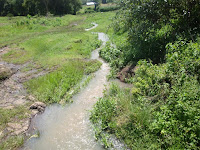The Slow Death of Dawani River
 |
| Dawani River |
That Dawani,
or aptly put, Wanyororo River, is on a death knell is not in contention. Once
upon a time, Dawani River was a mighty one. It meandered through villages
filling three dams as its serpentine course took it all the way to Murunyu
village and beyond from Wanyororo hills.
Today, this
narrative is different. The far the river reaches (as of present) is Wanyororo
dam behind the Catholic Church. Residents down the river claim that only when
the rains are unrelenting, or at their peak, does the river flow the full
course. To them, the river died a natural death not long ago, for what today
passes for a river is a dry river bed that turns into a seasonal flow depending
on rain patterns.
A close look
at the three dams along the river’s course returns a grim picture. The dams are
a pale shadow of their former glory; shallow and heavily silted that one can
wade through, literally, and overrun with aquatic weeds. Are they really dams
or mere giant ponds that even a low earth satellite cannot pick?
Claims have
it some individuals have diverted the river’s course to pass through their farms for irrigation purposes, or even
made illegal dams checking its downward progress.
But how did
the river’s slow and gradual death begin?
At the
height of Moi’s regime, especially during the mid 1990s, anyone with a power saw,
or whoever could bribe the authorities of the day, was a licensed logger. The great
carpet of forest that protected the river’s source disappeared as trees fell in
quick succession. By the time the last of power saws went silent, the hills had
been laid bare, exposing the water catchment. To make an already dire situation
worse, many peasants were allocated minuscule pieces of land to till, on what
was seen as one of ways of addressing or boosting food security in an otherwise
food secure zone.
 |
| Riverside dam |
The effects
of these misguided decisions were not long in coming. Surface runoff waters leached
fertilizer rich soils into the river whenever it rained. As these nutrients-rich
soils silted along the river’s course and into the dams, plants of every shade
took hold, and overrun water surface overnight. Dams became a mass of weeds,
and their holding capacities reduced. It is no surprise that during dry
seasons, the rate of evaporation is high, meaning it takes little time for
whatever amount of water is left to empty out (mainly through fetching for
domestic and other uses).
Enter the Kibaki
regime, and a company by name of Comply was contracted to reforest the whole
denuded place. One would have expected a forest cover in a decade, taking into
account the claims the trees planted were of a fast maturing variety. That is
far from reality, with tree cover relatively low, and some parts of forest land
still serving as shambas for some
peasants.
Conventional
wisdom would have it that with the forest in place, the swampy water catchment areas
would have been restored to their glorious past. That is not the case!
Witness the
present state of the river. It is nothing short of a seasonal trickle. Whereas in
the past this river used to flow all year round, nowadays rain patterns dictate
its flow chart. A worrying trend, however, has set in place. Whenever it rains,
surface runoff flows on our roads for weeks on end, and with a higher cubic
volume than what the river carries!
 |
| Surface runoff |
No one, it seems,
has seen the wisdom of harnessing this runaway water by channeling it into the
river. When we have inept leaders in place, what can one expect? (A case in
point, the Wanyororo Farmers Co. Ltd is a real letdown. It has failed in its
mandate, like in protecting or fighting for our resources. When did this group
of sellouts hold an annual general meeting last? Has there been a change of its
directors in decades?)
 |
| Catholic dam |
When you
realize that even piped water is a luxury, and not a necessity in many places,
you will begin to realize the enormity of the situation. A looming water crisis
is not far off, unless measures are taken to redress the situation.
And it will
come as no surprise when someone will form a briefcase NGO, and cash on
handsomely, in name of mobilizing for finances to protect this water catchment
area.



Comments
Post a Comment